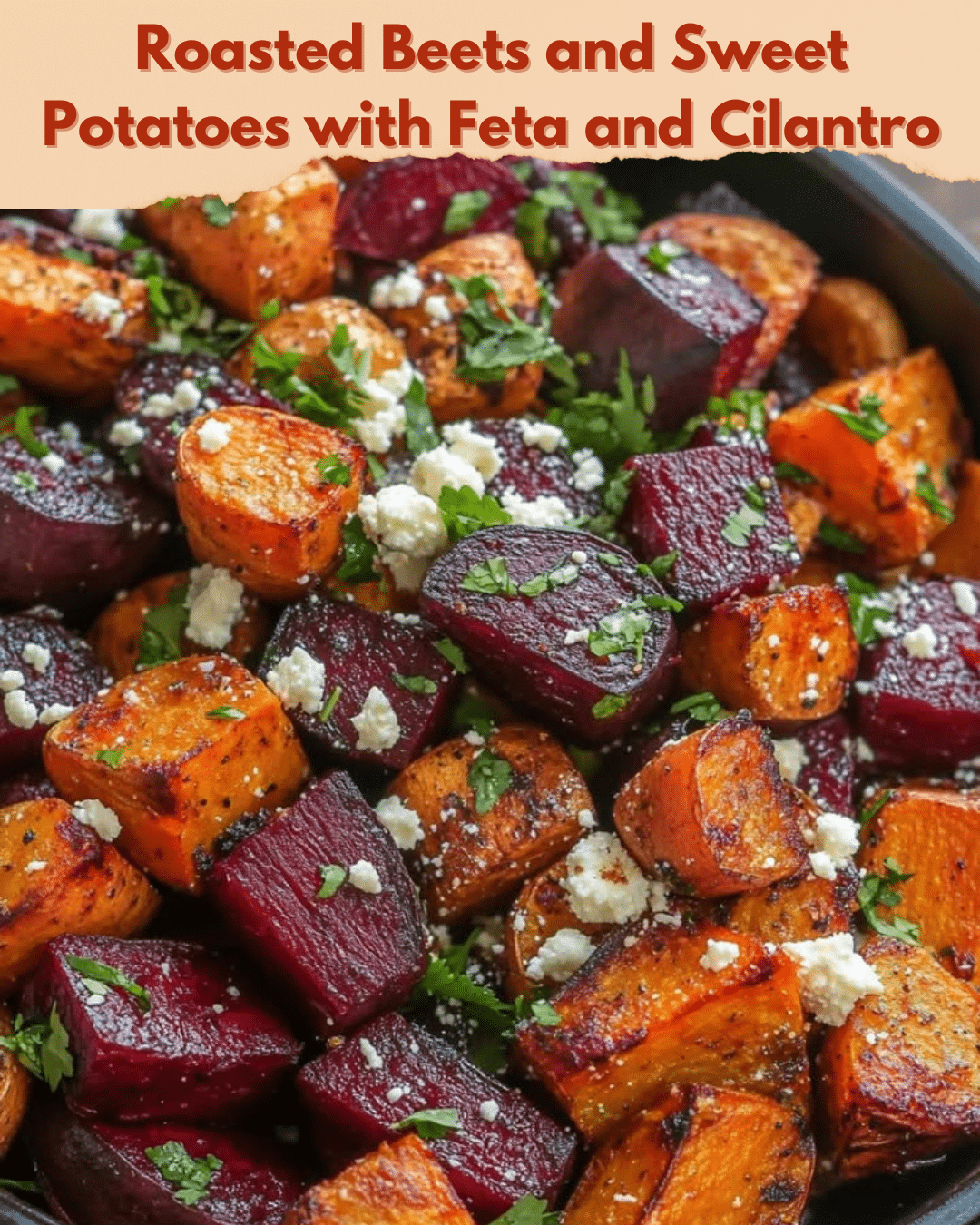Roasted Beets and Sweet Potatoes with Feta and Cilantro: A Flavorful Delight
Roasted Beets and Sweet Potatoes with Feta and Cilantro is a vibrant and delightful dish that’s perfect for any occasion. This recipe combines the earthy sweetness of roasted beets and sweet potatoes with the sharp, tangy taste of feta cheese and the fresh, aromatic notes of cilantro. Whether you’re looking for a side dish to complement your main course or a colorful addition to a potluck, this recipe is sure to impress with its stunning presentation and mouthwatering flavors.
The aroma of fresh cilantro mingling with roasted root vegetables creates an enticing sensory experience. When you drizzle a light dressing of olive oil and balsamic vinegar over the dish, it elevates the natural flavors and adds a touch of gourmet flair. Roasted Beets and Sweet Potatoes with Feta and Cilantro offers a beautiful balance of flavors, colors, and textures, ensuring that each bite delivers a perfect harmony of tastes.
Quick Recipe Highlights
- Flavor Profile: This dish boasts a harmonious blend of sweet, savory, and tangy flavors, thanks to the roasted beets and sweet potatoes, crumbled feta, and fresh cilantro.
- Texture: Enjoy the tender, caramelized texture of the vegetables alongside the creamy crumbliness of the feta cheese.
- Aroma: The aromatic freshness of cilantro beautifully complements the earthy scent of roasted root vegetables.
- Visual Appeal: A colorful array of vibrant orange and deep red makes this dish visually striking and appetizing.
- Skill Level Needed: With simple roasting techniques and minimal preparation, this dish is accessible to cooks of all levels.
- Special Equipment: A quality baking sheet and a knife sharp enough to slice through firm vegetables make preparation straightforward and effective.
Recipe Overview
- Difficulty Level: This recipe is designed to be approachable, even for novice cooks. With clear steps and little chance for error, it’s an ideal choice for those looking to expand their skillset without stress.
- Category: Perfect as a side dish, main course, or even a potluck favorite, this versatile recipe suits a variety of meal categories.
- Cuisine: This recipe takes inspiration from Mediterranean cuisine, blending classic flavors and ingredients for an authentic taste experience.
- Cost: Utilizing common ingredients like beets, sweet potatoes, and feta, this dish is budget-friendly without compromising on flavor or presentation.
- Season: Best enjoyed during the fall harvest when beets and sweet potatoes are at their peak, bringing the freshest flavors to your table.
- Occasion: From casual family dinners to festive holiday gatherings, this recipe is suitable for any occasion where a splash of color and taste is needed.
Why You’ll Love This Recipe
Taste and Texture Appeal: The combination of sweet vegetables with creamy, salty feta creates a delightful contrast that will satisfy anyone’s taste buds. With a fine balance between varied textures, each bite is both comforting and exciting.
Convenience and Preparation Benefits: This recipe requires minimal preparation, making it a convenient option for busy evenings or large get-togethers. With most of the cooking hands-off, it allows ample time to attend to other dishes or engage with guests.
Nutritional Advantages: Roasted Beets and Sweet Potatoes with Feta and Cilantro is loaded with vitamins and antioxidants, promoting health benefits like improved digestion and immunity support, all on one appealing plate.
Social and Entertaining Value: As a visually stunning dish with a universal flavor appeal, it’s perfect for entertaining. Its vibrant colors will spark conversation and its delectable taste will delight guests of all palates.
Cost-effectiveness and Accessibility: Using inexpensive vegetables and minimal ingredients, this dish provides an affordable and accessible option that doesn’t sacrifice sophistication or flavor.
Historical Background and Cultural Significance
Origin Story: Roasted vegetables have been a staple in many cultures for centuries, reflecting simplicity and versatility in culinary traditions. This recipe draws from rich Mediterranean influences, where roasted vegetables are beloved for their rich flavors and wholesomeness.
Cultural Importance: In Mediterranean cuisine, the use of olive oil, fresh herbs, and feta cheese is a nod to both health-conscious eating and deep culinary heritage, emphasizing a balance of taste and nutrition.
Evolution of the Recipe: Over time, this recipe has evolved to incorporate popular contemporary ingredients like sweet potatoes, reflecting culinary expansion and creative adaptation while still holding its traditional roots.
Regional Variations: Across regions, variations might include the addition of spices like cumin or paprika, aligning with local flavor preferences and ingredient availability.
Ingredient Deep Dive
Beets: Known for their deep color and natural sweetness, beets offer significant health benefits, including high levels of iron and vitamin C. They can be stored unwashed in the refrigerator to preserve freshness and can be substituted with radishes for a slightly different flavor.
Sweet Potatoes: Sweet potatoes provide a rich source of vitamins A and C and are highly versatile. Select firm, clean sweet potatoes for the best quality, and store them in a cool, dry place away from direct sunlight.
Feta Cheese: Feta adds a creamy, tangy element to the dish, integral to Mediterranean meals. It should be kept refrigerated in brine or its original packaging to maintain its texture. For a different flavor, try substituting goat cheese.
Cilantro: Fresh cilantro offers vibrant flavor and garnish, full of antioxidants and vitamins. Store wrapped in a damp paper towel and placed in a plastic bag in the fridge to maintain its freshness, or swap with parsley for a milder profile.
Common Mistakes to Avoid
- Under-roasting vegetables, resulting in a crunchy texture instead of tender.
- Overcrowding the baking sheet, leading to steaming rather than roasting.
- Neglecting to toss the vegetables halfway, which can cause uneven cooking.
- Adding feta too early; it may melt away rather than retain its crumbly texture.
- Skipping fresh herbs, resulting in a less vibrant flavor.
- Over-seasoning which can overwhelm the natural sweetness of the vegetables.
- Not allowing the dish to rest, giving it time for flavors to meld together.
- Forgetting to preheat the oven, which can result in inconsistent cooking.
Essential Techniques
Roasting: Mastering the art of roasting unlocks depth of flavor and caramelization. Ensure an even coating of oil, adequate spacing on the baking sheet, and precise temperatures to achieve golden, tender vegetables.
Knife Skills: Skillfully dicing vegetables ensures uniform cooking and professional presentation. Focus on maintaining consistent size and shape for even roasting.
Balancing Flavors: Effective flavor balancing between sweet, tangy, and salty creates a harmonious dish. Always taste as you go, adjusting seasoning gradually.
Plating Presentation: Artful plating enhances visual appeal, with deliberate placement of contrasting colors and textures. Experiment with stacked arrangements and thoughtful garnishes to impress.
Pro Tips for Perfect Roasted Beets and Sweet Potatoes
Choose vegetables of similar sizes for uniform cooking and consistent texture.
Achieve crispy edges by ensuring vegetables are dry before roasting and not crowded on the baking sheet.
Layer flavors by adding spices such as garlic powder or cinnamon directly to the olive oil before tossing with vegetables.
Incorporate a splash of lemon juice over the top for added acidity and brightness just before serving.
Crumbled feta should be evenly distributed to ensure each bite has a balanced taste.
Opt for fresh cilantro added just prior to serving to keep its leaves bright green and flavors vibrant.
Experiment with flavored oils, such as herb-infused olive oil, for an additional depth of flavor.
To amplify richness, drizzle a hint of high-quality balsamic reduction after cooking.
Variations and Adaptations
Regional variations include substituting olive oil with ghee or butter in Indian-inspired adaptations for a creamier taste.
Seasonal adaptations could see the inclusion of pumpkins or squash in the fall, aligning with seasonal produce.
Dietary modifications make this dish nutritious for vegans by excluding feta or using a plant-based cheese alternative.
Flavor variations can be enhanced with herbs like rosemary and thyme, adding complexity without overwhelming the primary ingredients.
Texture modifications might involve less roasting for a firmer bite, depending on personal preferences.
Presentation alternatives include layered salads or serving on a bed of quinoa for a complete meal option.
Serving and Presentation Guide
For an elegant presentation, arrange roasted vegetables in a layered pattern on a platter, with feta and cilantro artfully scattered on top.
Consider garnishing with toasted seeds or nuts to add both crunch and additional flavor depth.
Serve roasted beets and sweet potatoes alongside grilled proteins for a balanced and nutritious meal.
Incorporate a vinaigrette drizzle for added moisture and color contrast on the plate.
Maintain a serving temperature at a gentle warmth to maximize the fresh flavors of added herbs.
Portion control can be observed by serving the dish in individual bowls or plates for a more personalized experience.
Wine and Beverage Pairing
Pair Roasted Beets and Sweet Potatoes with a crisp white wine, such as Sauvignon Blanc, that complements the tanginess of feta.
For non-alcoholic options, a lightly sweetened herbal iced tea or a sparkling water infused with lime works well.
Coffee and tea pairings could involve a light-bodied green tea, bringing a refreshing element to the meal.
Temperature considerations ensure beverages are chilled or gently warmed to cleanse the palate, marrying perfectly with dish flavors.
Serving wine in wide-mouthed glasses enhances the experience by allowing flavors to open up.
Storage and Shelf Life
Roasted vegetables can be stored in an airtight container in the refrigerator for up to three days, retaining freshness and flavor.
Temperature of around 40°F preserves quality and prevents bacterial growth.
Opt for glass or BPA-free plastic containers, ensuring a tight seal to prevent moisture loss.
Signs of spoilage include discolored spots or an off smell. Consuming only while fresh is advised.
Reheat gently on a stovetop or oven to prevent turning soft or mushy.
Freeze leftovers if needed, but be aware of possible texture changes, especially with cheeses.
Make Ahead Strategies
Prepare vegetables and dice them in advance, storing them in airtight containers to hasten preparation time.
Store roasted elements separately to retain their texture. Assemble only when ready to enjoy for optimal freshness.
Analyze how preparing ahead might impact flavor, ensuring adjustments are made to maintain dish brilliance.
Keep dressing aside, applying only just before serving to retain crispness.
Re-heat any pre-prepared layers individually to sustain integrity of flavor and texture.
Add fresh components such as herbs only post-reheating to maintain their vibrancy.
Scaling Instructions
To halve the recipe, simply reduce ingredient measurements accordingly, paying attention to cooking times as they may vary slightly.
Doubling or tripling the recipe necessitates additional baking sheets to prevent crowding and ensure consistent roasting results.
Adjust equipment as needed, utilizing larger mixing bowls and baking trays for larger quantities.
When scaling recipes, timing can be adjusted by monitoring doneness with a fork or knife test, rather than strict time adherence.
Consider storage limitations when preparing for large groups, ensuring ample space to keep everything fresh.
Nutritional Deep Dive
This dish offers a balanced macro breakdown rich in fiber from sweet potatoes and lean protein from feta.
Micronutrient analysis shows high levels of manganese, potassium, and vitamin K, valuable for metabolic and bone health.
Health benefits include antioxidants and anti-inflammatory properties from beets, supporting general wellness.
Dietary considerations accommodate many preferences, with possibilities for further adaptation as discussed.
Portion analysis ensures that even modest servings provide substantial nutritional benefits.
Weight management tips include balancing portions with an increased focus on vegetables, reducing any additional carb intake.
Dietary Adaptations
Gluten-free naturally, making it safe for those with gluten sensitivities without any special modifications.
Dairy-free options can be enacted with coconut-based cheese alternatives for those lactose intolerant.
Vegan adaptations simply swap the feta for popular alternatives like almond or cashew cheese.
Low-carb variations emphasize high vegetable ratios, reduced carb volume through controlled potato portions.
Keto alignment can be closely monitored using cheese and increased healthy fats, such as avocado oil.
Paleo modifications respect whole-food integrity, often removing the cheese or replacing it with a permissible substitute.
Low-FODMAP versions might be carefully adjusting serving sizes and ingredient types to adhere to specific dietary limits.
Troubleshooting Guide
Troubles with texture often arise from insufficient roasting, commanding patience and appropriate knife readiness for testing doneness.
Flavor balance can tip precariously, employ restraint and incremental amplifications for optimal results.
Temperature control often defines success; calibrating appropriate preheating ensures consistent results.
Equipment challenges might require interim solutions or investments in reliable baking setups for best outcomes.
Ingredient substitutions, even with availability constraints, necessitate careful consideration to preserve dish identity.
Timing concerns should align with detailed preparation plans, where preparedness underpins consistent delivery.
Recipe Success Stories
Community enthusiasm frequently highlights the dish’s versatility and success across dietary preferences and occasions.
Readers celebrate variation successes, with delightful customization suggestions like added citrus or nut toppings.
Adaptation stories frequently surface, resonating with local produce uses or flavor preferences, further enriching its appeal.
Reader suggestions often inspire creative ingredient presentations and unique serving style experimentation.
Photography tips spotlight the vibrant character of the dish, focusing on naturally lit and staged captures for impressive visual storytelling.
Frequently Asked Questions
Can I use other root vegetables?
Absolutely! Carrots or parsnips work well and complement the dish’s sweet and savory notes.
How can I store leftovers?
Keep them in an airtight container in the fridge, ensuring minimal air contact to maintain freshness.
Is it possible to prepare this dish the day before?
Yes, components can be prepped ahead but for maximum freshness, combine ingredients just before serving.
What can I use instead of feta cheese?
Goat cheese is a delicious alternative; for a vegan choice, look to plant-based cheese made from nuts.
Are there any non-dairy substitutes suitable for this dish?
Coconut-based cheeses bring similar richness and complement the sweetness of the roasted vegetables.
How do I ensure my vegetables roast evenly?
Cut them uniformly, ensuring similar sizes for equal cooking times, and rotate the pan halfway through roasting.
Can I enjoy this dish cold?
Chilled offers a refreshing twist, particularly during warm seasons, though flavors are more pronounced warm.
How is the dish served best?
At room temperature or slightly warm ensures flavors shine through, with soft, balanced textures.
What other dressings could enhance this dish?
Balsamic glaze provides richness, while lemon vinaigrette adds a tangy brightness for dynamic contrast.
Is there a specific order of adding ingredients?
Add fresh herbs at last to retain their most vibrant flavor and color, while vegetables and cheese can integrate readily.
Additional Resources
Explore related recipes like Mediterranean salads or roasted dishes that share ingredient sensibilities and preparation methods.
Technique guides offer step-by-step processes for perfect roasts, seasoning, and plating, ensuring culinary success.
Ingredient information includes sourcing tips and homegrown suggestions to deepen flavor understanding and choice exploration.
Equipment recommendations can refine technique execution, with insight into preferred brands for long-term kitchen investments.
Seasonal variations inspire new combinations in line with changing produce availability, promoting creativity and alignment.
Print
Roasted Beets and Sweet Potatoes with Feta and Cilantro
Description
A vibrant, healthy side dish of roasted beets and sweet potatoes topped with feta cheese and fresh cilantro.
Ingredients
For the Crust:
- 2 medium beets, peeled and diced
- 2 medium sweet potatoes, peeled and diced
- 2 tablespoons olive oil
- Salt and pepper to taste
- 1/4 cup crumbled feta cheese
- 1/4 cup fresh cilantro, chopped
Instructions
1. Prepare the Crust:
- Preheat the oven to 400°F (200°C).
- Toss the diced beets and sweet potatoes with olive oil, salt, and pepper. Spread them evenly on a baking sheet.
- Roast in the oven for 25-30 minutes or until tender and lightly browned. After removing, sprinkle with feta and cilantro before serving.
Notes
You can customize the seasonings to taste.





